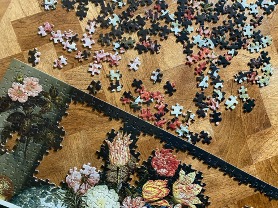by Laura Sevilla ’24
It took me an embarrassing number of years to defy standards enforced by ancient academic models for “writing success.” Of course the guidelines for writing repeatedly given by pre-college worksheets proved helpful for some, but I felt lost. I couldn’t wrap my brain around writing everything out chronologically when I could form full sentences that I knew would eventually end up somewhere in my paper. As early as elementary school, I received outlining sheets that asked for each topic and transition sentence with a bullet list of my evidence between. The paper would end up crumpled at the bottom of my bag alongside some forgotten bag of potato chip fragments. My brain ached when it was required to work within these lines.

Soon, I found myself in high school where there was hardly any guidance for writing. The tried-and-true CER (claim, evidence, reasoning) method from middle school had guided me a bit, but I was still lost when it came to assignments. How do I even begin to piece things together?
One night, after many tears at my kitchen table and the rest of my family had gone to bed, I was so frustrated that I started completely randomly. I knew my conclusion needed to have a particular point mentioned, so that was the first thing I wrote down. As the sentences came to mind, I typed–left with my entire paper in list form. After a copy and paste frenzy of rearranging my sentences into set paragraphs, I was done. I submitted my work and waited, anticipating a low grade like the rest of my papers. To my surprise, I received higher than 100%.
I called it the puzzle process–and I LOVE puzzles. As I understood myself as a person and writer more (hello ADHD diagnosis!), it just made sense.

In high school, my favorite English teacher gave me two rules to guide this process, and I think about them even as I’m writing this now. He was the first teacher I had to recognize unorthodox writing practices work well for some, and I was a much better writer for it.
- The Home Run
- Writing inspired full sentences out of order can result in wordy, vocab-dense phrases. If every sentence you have down so far is the result of an “a-ha!” moment, chances are a number of them sound complex. This doesn’t mean the sentences you have down aren’t beautifully written or impactful, but not everything should sound intricate. It’s overwhelming for the reader, and your focus can get lost behind the language. Sometimes, concise and short sentences make your point that much clearer.
- The Blender
- When my paper reached list form, I needed to be very intentional about rearranging. If all my sentences were put in a blender and spit back out, would it read the same? It’s helpful to add some strong transition words and phrases for flow, but sometimes it’s good to reassess placement.
Using the puzzle process guided me through each college writing assignment, and I can’t imagine making it through my English degree without it. I wish I could have told myself that writing didn’t need rules sooner, but I am endlessly grateful that more writers are shaping their processes to their individual needs. I’m sure that everyone has a puzzle process out there–and none of them look completely identical. 🙂
